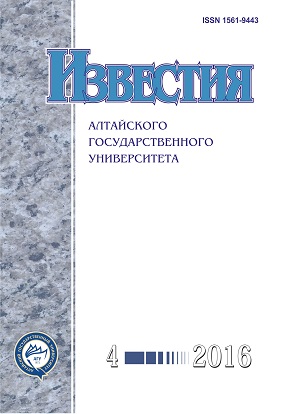Eneolithic Age Mounds of the Inskoy Dol Burial Ground in Altai
Abstract
The article is devoted to the preliminary results of the st udy of burial mounds № 4 –7, 9 on the burial ground of the Inskoy Dol, situated in the Krasnoshchekovskiy district of the Altai Territory (Western Altai). Investigated objects complement the information on the late Stone Age of souther n Siber ia. A nalysis of planig raphy, the burial rite and inventory provided the opportunity to distinguish two of the small groups of mounds on the Inskoy Dol burial site. The f irst group of barrows № 4–5, 9 has the characteristic features of Afanasyevo culture and pre-dated to 3rd Millennium BC. The characteristic signs of Afanasyevo culture include planographics of the particular location of the object and the tomb designs of a round shape, where along the perimeter one can find the ring plates, set vertically and the stones laid flat; ground graves where the dead were placed on the back with bent knees and feet oriented the head to the west; painting the dead with red ochre; the receptacles ovoid. The second microgroup of mounds № 6–7 refers to the so-called Kurtusk type of burials and dated to pre- mid-3rd Millennium BC. This type is characterized by the following features of the burial rite: round structure of tombs, the position of the dead in subterranean graves on the back with bent knees feet; the orientation of the dead head to the east, north-east; painting of the dead with ochre. In addition, as a rule, such burial do not contain any inventory or they contain mainly the vessels of the jar type. Further study of the monument, as well as carrying out radiocarbon analysis will allow providing new data for chronological attribution of the objects. DOI 10.14258/izvasu(2016)4-39Downloads
Metrics
References
Дашковский П.К. Курган афанасьевской культуры на могильнике Инской дол // Сохранение и изучение культурного наследия Алтайского края. - Вып. XXI. - Барнаул, 2015.
Дашковский П.К., Мейкшан И.А. Исследование курганов скифского времени на могильнике Чинета-II и Инской дол // Сохранение и изучение культурного наследия Алтайского края. - Вып. XX. - Барнаул, 2014.
Дашковский П.К., Гончарова Н.С., Мейкшан И.А. Продолжение исследования курганов на могильнике Инской дол // Полевые исследования в Прииртышье, Верхнем Приобъе и на Алтае. 2014 г.: археология, этнография, устная история. - Вып. 10. - Барнаул, 2015.
Ларин О.В. Афанасьевская культура Горного Алтая: могильник Сальдяр- 1. - Барнаул, 2005.
Афанасьевский сборник : сборник научных статей / отв. ред. Н.Ф. Степанова, А.В. Поляков. - Вып. I. - Барнаул, 2010.
Афанасьевский сборник 2 : сборник научных статей / отв. ред. Н.Ф. Степанова, А.В. Поляков. - Вып. II. - Барнаул, 2012.
Кирюшин Ю.Ф., Грушин С.П., Степанова Н.Ф., Тюрина Е.А. Афанасьевские погребальные комплексы средней Катуни (результаты исследований Катунской археологической экспедиции в зоне строительства и затопления Алтайской ГЭС в 2006-2007 гг.). - Барнаул, 2010.
Вадецкая Э.Б., Поляков А.В., Степанова Н.Ф. Свод памятников aфанасьевской культуры. - Барнаул, 2014.
Степанова Н.Ф. Афанасьевская культура Горного Алтая и Енисея: погребальный обряд и керамика (сходство и различие) // Афанасьевский сборник. - Вып. I. - Барнаул, 2010.
Степанова Н.Ф. Афанасьевская культура Горного Алтая и погребения куротинского типа // Афанасьевский сборник 2. - Вып. II. - Барнаул, 2012.
Шульга П.И. Погребения эпохи энеолита-бронзы в долине Сентелека // Погребальные и поселенческие комплексы эпохи бронзы Горного Алтая. - Барнаул, 2006.
Цыб С.В. Афанасьевская культура Алтая : автореф. дис.. канд. ист. наук. - Кемерово, 1984.
Молодин В.И. Горный Алтай в эпоху бронзы // История Республики Алтай. - Горно-Алтайск, 2002. - Т. I.
Степанова Н.Ф. Проблемы абсолютной и относительной хронологии памятников афанасьевской культуры Горного Алтая // Роль естественно-научных методов в археологических исследованиях. - Барнаул, 2009.
Поляков А.В. Радиоуглеродные даты афанасьевской культуры // Афанасьевский сборник. - Вып. I. - Барнаул, 2010.
Хлобыстина М.Д. Древнейшие могильники Горного Алтая // Советская археология. - 1975. - № 1.
Погожева А.П. Афанасьевская культура // Погожева А.П., Рыкун М.П., Степанова Н.Ф., Тур С.С. Эпоха энеолита и бронзы Горного Алтая. - Барнаул, 2006. - Ч. I.
Савинов Д.Г. Могильник Бертек-33 // Древние культуры Бертекской долины (Горный Алтай, плоскогорье Укок). - Новосибирск, 1994.
Бородовский А.П. Афанасьевские памятники Нижней Катуни // Погребальные и поселенческие комплексы эпохи бронзы Горного Алтая. - Барнаул, 2006.
Кузьмин Н.Ю. Генезис саяно-алтайского шаманизма по археологическим источникам // Северная Евразия от древности до средневековья : тезисы докладов конференции к 90-летию со дня рождения М.П. Грязнова. - СПб., 1991.
Izvestiya of Altai State University is a golden publisher, as we allow self-archiving, but most importantly we are fully transparent about your rights.
Authors may present and discuss their findings ahead of publication: at biological or scientific conferences, on preprint servers, in public databases, and in blogs, wikis, tweets, and other informal communication channels.
Izvestiya of Altai State University allows authors to deposit manuscripts (currently under review or those for intended submission to Izvestiya of Altai State University) in non-commercial, pre-print servers such as ArXiv.
Authors who publish with this journal agree to the following terms:
- Authors retain copyright and grant the journal right of first publication with the work simultaneously licensed under a Creative Commons Attribution License (CC BY 4.0) that allows others to share the work with an acknowledgement of the work's authorship and initial publication in this journal.
- Authors are able to enter into separate, additional contractual arrangements for the non-exclusive distribution of the journal's published version of the work (e.g., post it to an institutional repository or publish it in a book), with an acknowledgement of its initial publication in this journal.
- Authors are permitted and encouraged to post their work online (e.g., in institutional repositories or on their website) prior to and during the submission process, as it can lead to productive exchanges, as well as earlier and greater citation of published work (See The Effect of Open Access).








